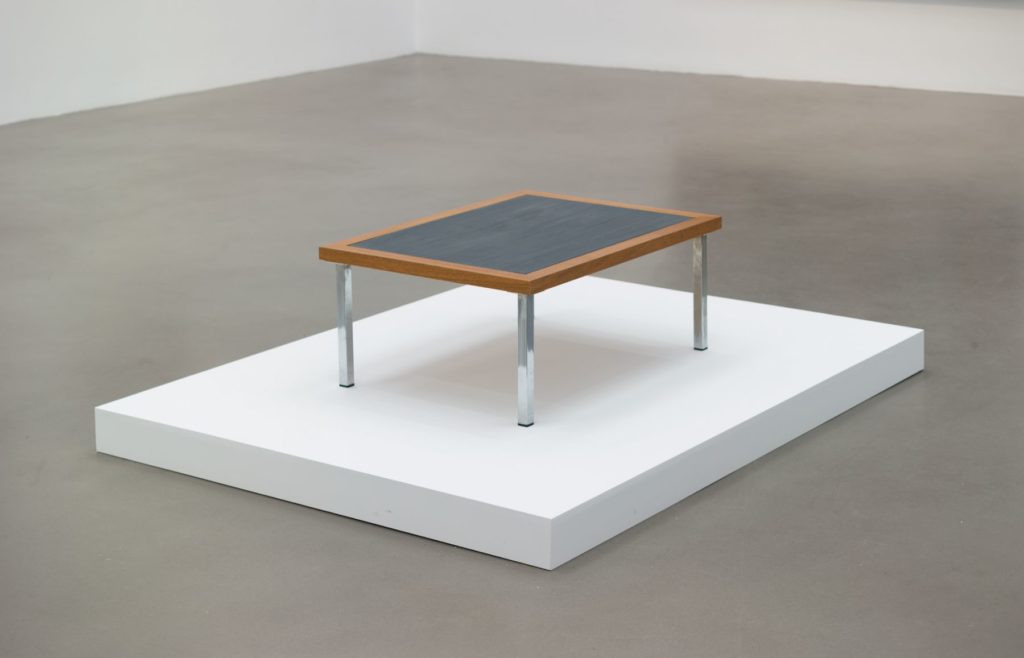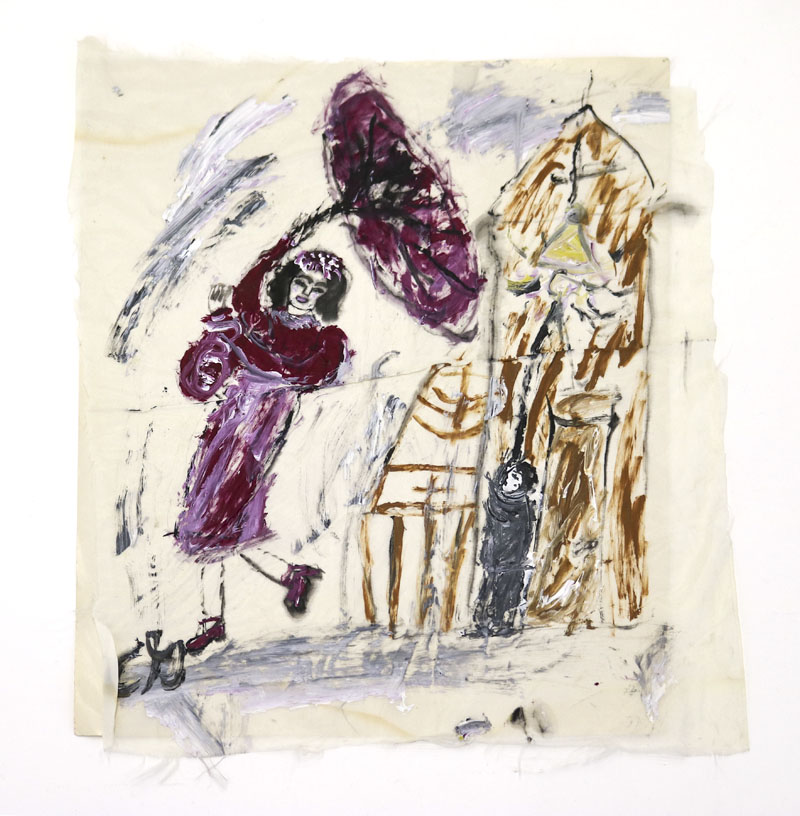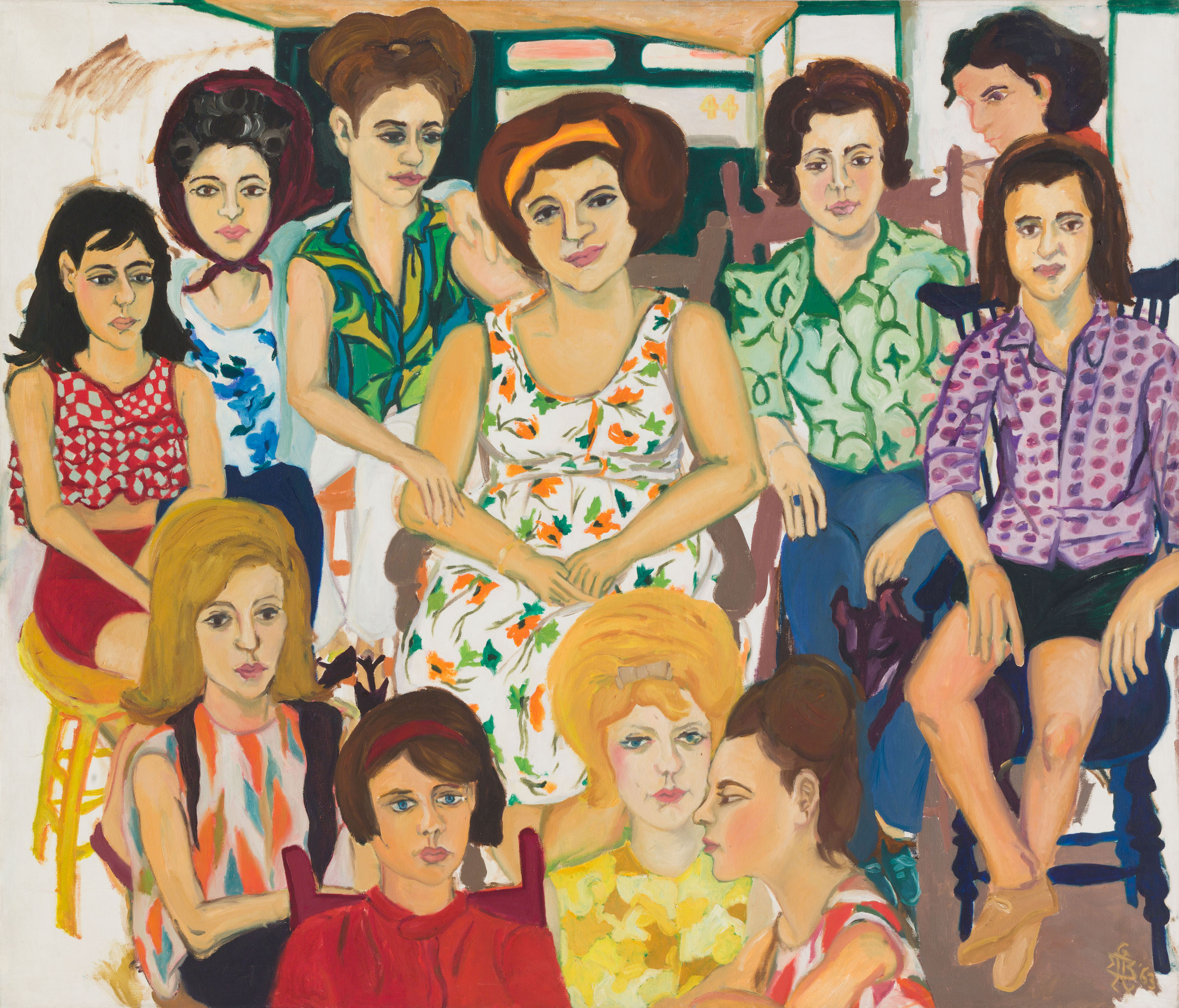[ad_1]

In “Strategic Vandalism” at Petzel: Martin Kippenberger, Model Interconti, 1987, wood, metal, Gerhard Richter painting from 1973, 12.6 x 31.3 x 23.2 inches.
COURTESY PETZEL
Every once in a while—perhaps just a couple times a year—the galleries of New York are in peak form, unearthing deep cuts by famed artists, highlighting toothsome new talent, and allowing reliable figures to unveil strong new work. Now is one of those very special moments. Below, six reviews of excellent exhibitions in Manhattan, plus one more recommendation.
Dear Painter, Paint for Me
Petzel’s Chelsea space is currently home to one of the great, ridiculous, patricidal artworks of the past few decades: Martin Kippenberger’s Modell Interconti (1987), which involved the German painter turning a gray Gerhard Richter monochrome into a table. But that is just one of the many exhilarating moments in “Strategic Vandalism: The Legacy of Asger Jorn’s Modification Paintings,” a superb show of artists being very bad. The curators of this paean to détournement, artist Axel Heil and critic Roberto Ohrt, have Marcel Duchamp placing a neat mustache on the Mona Lisa, Jorn splashing a beard across a child in a found portrait, and Enrico Baj depicting gnarly monsters around readymade paintings of nude women. Machismo, to be sure, is flowing, but Betty Tompkins is among those on hand to dissent, covering women in reproductions of classic paintings with the language sometimes used to describe them. One imagines that Guy Debord and company would revel in the festivities, at least until they saw the price list. (Through April 13)

Caroline Goe, Untitled, n. d. (c. 1970s/’80s), mixed media on fabric laid on paper, 11 x 14 in.
COURTESY WHITE COLUMNS
A Joy Forever
Caroline Goe’s paintings on little slices of paper at White Columns are quickly brushed and radiantly colored—in a word, blissful. A scene of a woman in a cranberry-colored outfit losing her umbrella (or flying, perhaps!) has traces of Marc Chagall and Florine Stettheimer. And a bounty of flowers—swirling pinks and roses with hits of green—in a plump vase has some of the meatiness of Marsden Hartley. That Goe, whose whereabouts are currently unknown, sold her work along the streets of the East Village in the 1970s and ’80s for a buck or two astonishes—and rankles. Thankfully, the gimlet-eyed writer Lynne Tillman purchased many of her works at the time, and she’s loaned them for this show. It’s painful to speculate about how many have not been preserved. (Through May 4)

Installation view of “Notebook” at 56 Henry.
COURTESY 56 HENRY
Nota Bene
Quite often, while visiting the galleries of New York, I find myself agreeing with critic Dave Hickey’s proposal: “Ban all group shows. I’m tired of going to dinner and only getting the hors d’oeuvres table.” However, “Notebook” at 56 Henry is a powerful rebuttal to that notion—it’s a feast of small plates that provide tantalizing glimpses into the practices of 70-plus artists. The painter Joanne Greenbaum asked each to submit a drawing they “would never show to a dealer or pull out during a studio visit,” and the results range from the quirky to the profound. Polly Apfelbaum offers a sketch for a bird that appeared on a recent fabric work, and David Dupuis a tender little abstraction dedicated to the late Tony Feher. The most mysterious inclusion is a never-before-seen Cady Noland that appears to be a photocopy of John Gotti with handwritten bits of text across his face. (Through March 31)

Nolan Simon, Flood, 2019, oil and sublimation dye on linen, 60 x 44 inches.
COURTESY OF THE ARTIST AND 47 CANAL, NEW YORK/PHOTO: JOERG LOHSE
Head Over Heels
Nolan Simon, one of the most slyly inventive painters of the present moment, ascends to new heights in his third show at 47 Canal, “Other People.” Among the subjects of his indelible, exquisitely painted canvases: two hands that sprout from a pool of water to hold an iPhone, two empty coupé glasses held together by handcuffs, and a leather-shoed foot with a white-speckled black sock that curiously matches the floor surrounding it. And then there are his two paintings of oddly framed torsos, which heighten the uncanny mood of the whole affair. An oblique perversity pervades the room, good-natured laughter emerging from a certain darkness. (Through April 7)

Installation view of “Jessi Reaves: II” at Bridget Donahue; at left is Red eyelashes (2010), wood, leather, enamel, paint, glass, plexiglass, vinyl, lace, 42 ½ × 55 ½ × 24 in.
COURTESY BRIDGET DONAHUE
The Edge of Your Seat
Jessi Reaves’s first show at Bridget Donahue, in 2016, filled me with regret: If only I could be an art collector, I thought, able to take home her utterly lovable furniture pieces and enjoy them every day! Thankfully, one has not had to be without such pleasures for long. Reaves has had star turns at the 2017 Whitney Biennial and the recent Carnegie International in Pittsburgh, plus an effervescent 2018 solo show at the Aldrich Museum in Ridgefield, Connecticut. Now she has returned to Donahue with a new solo outing, “II,” in which she’s funkier and more rococo than ever. My favorite work right now is the jolly Red eyelashes (2019), a wooden shelf in vibrant pinks that has both sliding and hinged doors attached. Perched on a chair and topped with a pane of glass, it’s ready for any occasion. But I suspect my choice will soon change, given the raw charisma of the other bizarre and equanimous tables, bookshelves, and lights on view. When I stopped by, two children were running around—and leaping from—a sprawling stepped platform that Reaves has covered in brown carpet, having the time of their lives amid this ramshackle luxury. They certainly seemed to understand her work. (Through May 12)

Mimi Gross, Grand Street Girls, 1963, oil on canvas, 60 x 70 3/16 in.
COURTESY THE ARTIST AND ERIC FIRESTONE GALLERY
Street Style
Practically overflowing with radiant portraits, “Mimi Gross: Among Friends, 1958–63” at Eric Firestone Loft should be of the major crowd-pleasers of the moment, but it feels like it’s flying under the radar. Channeling a rare, quicksilver sense for detail, Gross was only in her late teens and early 20s when she made these pieces in crayon, paint, and pastel, working in New York, Provincetown, and Europe, where she and friends traveled northern Italy by horse-drawn carriage, doing shadow-puppet shows in small villages. (To think that young artists today believe a night at Berghain is bohemia!) Two highlights of many: Grand Street Boys and Grand Street Girls (both 1963), whose many young sitters look interesting enough to sustain a few seasons of prestige television about the Lower East Side during the Kennedy years. The show depicts an artistic life that was just getting started, and already being lived very well. (Through April 20)

Three Better Nutter cookies.
COURTESY BOUCHON BAKERY
Heaven Is a Place on Earth
Bouchon Bakery’s Better Nutter consists of two thick, butter-rich oatmeal cookies—a little chewy (thanks to creamy peanut butter) and a little crunchy (toasted peanuts, chopped)—sandwiching the smoothest buttercream in the land. It is a creation so satisfying, so perfectly salty and sweet, that it has been known to move me almost to tears. Big enough to serve as dessert for two, or one person after a long day of visiting galleries, the Better Nutter is the best thing that $4.25 can buy in this town. (Available in New York at 1 Rockefeller Plaza and 10 Columbus Circle.)
[ad_2]
Source link

